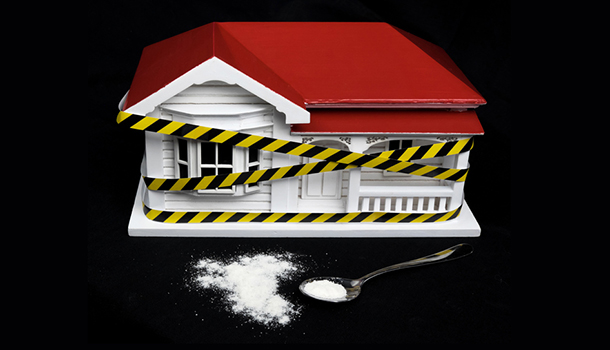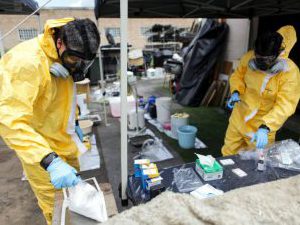
When you hear stories about methamphetamine the focus is generally on the user and the impact this drug has on the human body and behaviours.
Over the past year we have seen a different perspective become more prominent through Australian media channels focusing on contaminated homes as a result of meth manufacture and smoke, and the impact it may have on occupants, landlords, property managers and insurers to name a few.
When meth is manufactured and smoked, vapours that are released into the atmosphere permeate porous surfaces and crystallise, creating a residue. The human body absorbs these residues if contact is made with the contaminated surface.
Dr Jackie Wright from Flinders University who has been involved in (and continues to do) exceptional research in this area states in her thesis:
“Smoking methamphetamine is not the burning of methamphetamine, rather it is the heating of methamphetamine until it becomes an inhalable aerosol. The aerosols/residues that are produced and deposited during smoking of methamphetamine are considered to be the same as those produced during the manufacture of methamphetamine.”
What this confirms is that in the event of meth use (through smoking) or manufacture within a property, there is a high likelihood of pure methamphetamine residue remaining on any surrounding surface, including carpets, sofas, walls and in ventilation systems.
The Australian Clandestine Drug Laboratory Remediation Guidelines states that “the presence of methamphetamine on inside surfaces at a level of greater than 0.5 micrograms per 100 square centimetres is considered unacceptable”.
Laboratories analysing samples collected throughout the country are regularly reporting levels over the accepted 0.5 micrograms per 100 square centimetres.
One testing company recently stated that of the 342 homes they had tested over a six month period in South Australia, 54 per cent returned a positive reading. This statistic is not surprising given Australians are the biggest meth users per capita in the western world.
There is an absence of an Australian guideline specific to user sites and further direction (including a national standard) is required by the appropriate authorities to clarify how these are to be managed.
If, however residue from smoking is considered the same as residue from manufacturing, an addition to the current guidelines must be considered at the earliest to ensure greater clarity for those impacted e.g. landlords, tenants, property managers, insurers and industry service providers.
So how do we manage risk associated with meth contamination? Personally, I’m a big believer of the 4T’s of hazard risk response (ISO 31000) in terms of simplicity and application to every day risks: Tolerate, Treat, Transfer, Terminate.
Let’s have a look at a couple scenarios to which you could apply these.
- A property manager is responsible for managing and protecting the property assets of their clients. In doing so they will complete a due diligence process for any prospective tenants and once leased conduct routine inspections to ensure adequate upkeep and maintenance of the property. Although background checks can be an effective preventative control, they will not always wean out undesirable tenants leaving property managers to toleratethe associated risks. In this case it is important that detective controls are put in place to identify undesirable events after the fact. With regards to meth contamination, such controls would include a meth testing regime to:
- Determine a baseline at the start of each tenancy for comparison and
- Identify use and/or manufacture of the drug during a tenancy.
Both will act as a driver to terminate the tenancy, and the risk of increased contamination levels. Testing reports may also potentially be used to hold the tenant to account in the event of a tribunal.
- In terms of financial impact of a meth contaminated home, it is the property owner who will bear the brunt. In most instances a prudent landlord will transferthis risk to an adequate insurance provider who will in turn demand directive controls are followed to reduce the likelihood of a claim. Again, regular meth testing would be considered such a control ensuring that potential contamination is identified early enough to treat and prevent extensive remediation costs for the insurer. This control may also act as a deterrent as tenants will be aware that regular testing is enforced as part of their tenancy agreement.
A fundamental principle of effective risk management is ensuring that risk response is proportionate to the level of risk exposure.
For example, let’s say staff were taking office pencils home. The only way you could effectively prevent this would be to hire a security guard to check bags when exiting the building. Given the guards’ wages are probably higher than the value at risk (cost of the pencils) most companies would tolerate the risk.
Let’s look at the cost of meth testing as a risk response to determine whether it is proportionate to exposure.
The median rental price in Australia is approximately $440 ($22,880 annually). The cost of an instant meth test would start at $150 (0.66 per cent of rental income), or for a laboratory screening test at approximately $300 (1.32 per cent).
The cost of decontamination is generally between $5000 to $50,000. Risk appetite and tolerance differs for every landlord so as to whether this response is proportionate, I’ll leave that decision to them.
Isaac Southwell is director of Decon Systems Australia
Comment below to have your say on this story.
If you have a news story or tip-off, get in touch at info@3.106.117.80.
Sign up to INCLEAN’s newsletter.



I never knew that the cost of decontamination can be about $5,000. I suspect that the building I am leasing might have some problems like this. In my opinion, hiring a professional to test it would be the best option. https://methtesting.net.au/collections/meth-residue-testing